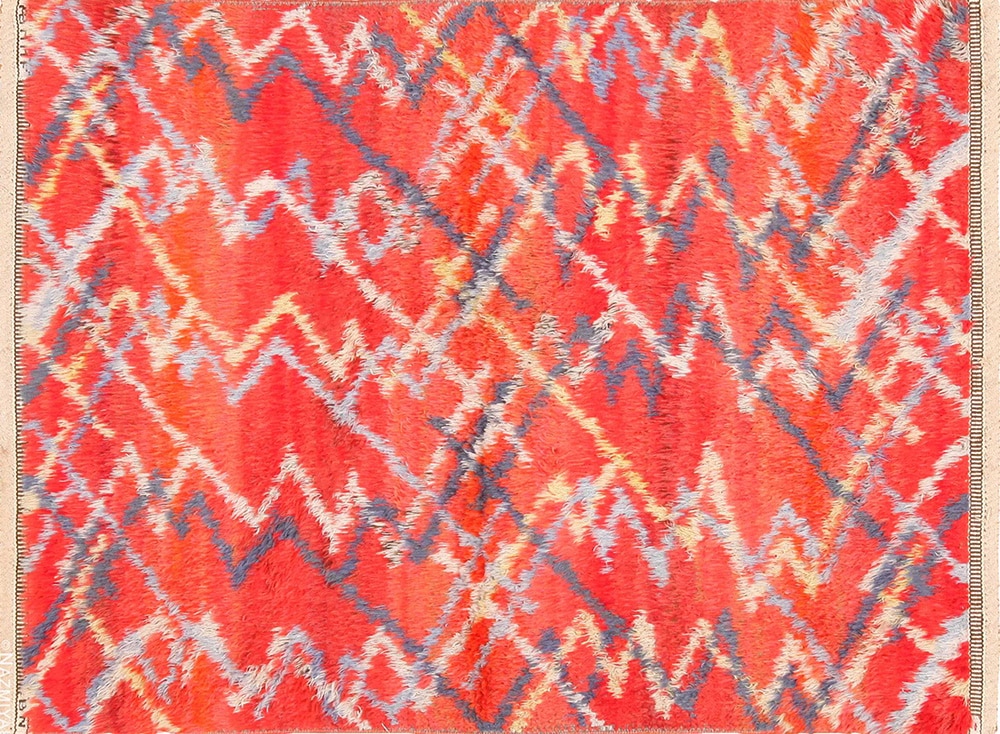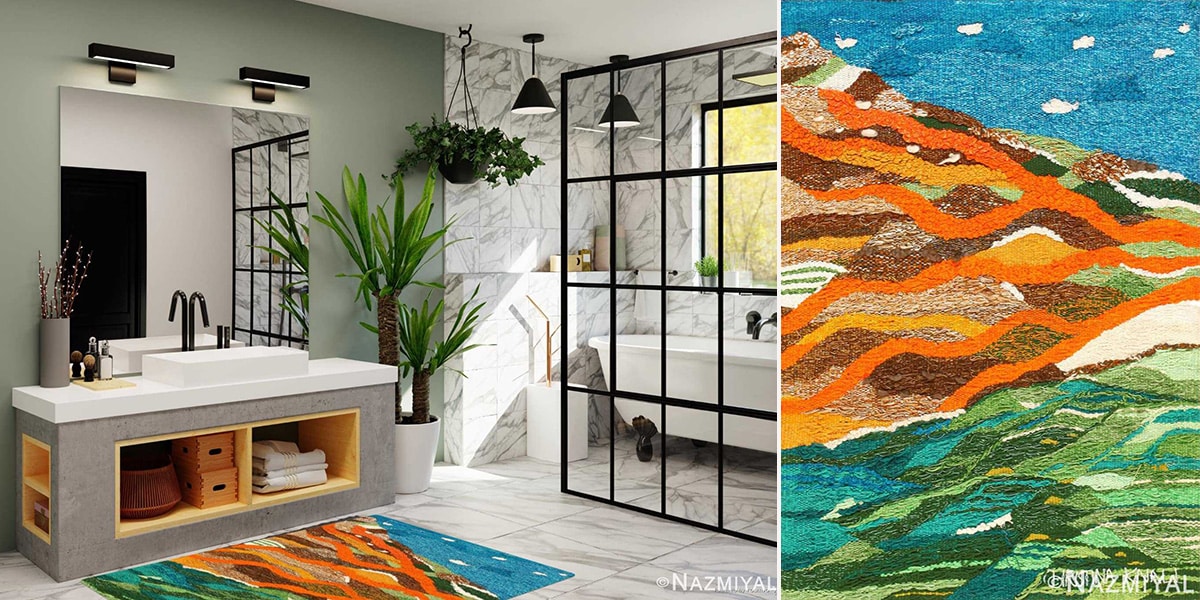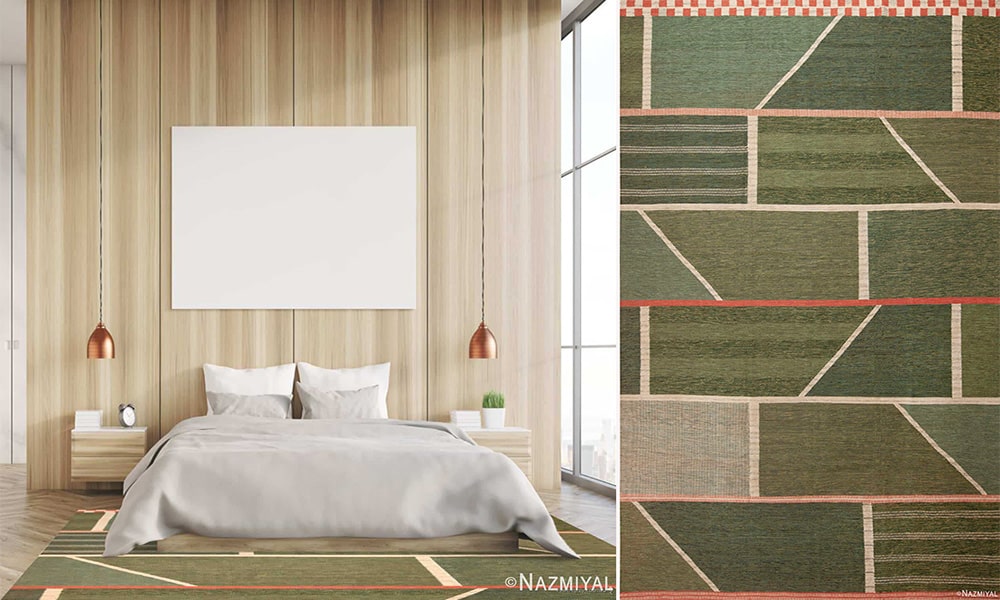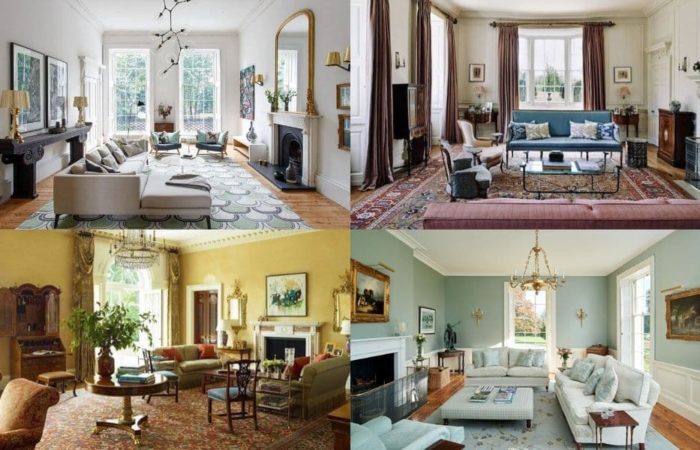Exploring the Cozy and Comfortable Hygge Home Decor and Interior Design Style
Shop All Scandinavian Rugs | Shop All Design Swedish Rugs | Shop All Vintage Swedish Shag Pile Rya Rugs | Create Your Own Unique Hygge Inspired Custom Rugs | Shop All Area Rugs From Scandinavia | Shop All Warm And Cozy Rugs
Shop All Vintage Rugs | Shop All Antique Rugs | Shop All Modern Rugs
The warm and cozy Hygge approach to deco and interiors
Hygge, a Danish and Norwegian concept, has evolved into a widely embraced lifestyle and design trend, offering a unique approach to creating warmth, comfort, and contentment within one’s living spaces. Rooted in Scandinavian culture, particularly in Denmark, hygge transcends mere aesthetics, representing a philosophy that revolves around cherishing the simple pleasures of life, fostering a sense of connection, and finding joy in the present moment.
This distinctive style emphasizes creating a cozy and inviting atmosphere, characterized by soft lighting, comfortable furnishings, and a harmonious blend of natural elements. Whether in the design of homes, cafes, or even entire cities, the hygge style prioritizes the pursuit of well-being and the cultivation of a serene, intimate environment where individuals can unwind and appreciate the beauty of life’s everyday moments.
For starters, what is hygge?
Hygge (pronounced “hoo-gah”) is a Danish and Norwegian term that represents a concept related to creating a cozy, comfortable, and content atmosphere. It’s often considered a lifestyle and design trend. Hygge encompasses a feeling of warmth, well-being, and simplicity. The focus is on enjoying the present moment and finding joy in everyday activities.
Key elements of hygge include:
- Comfort: Hygge emphasizes comfort in both physical and emotional aspects. Cozy blankets, soft lighting, and comfortable furniture contribute to the overall sense of well-being.
- Simplicity: Hygge encourages simplicity and minimalism. It’s about appreciating the little things and finding joy in uncomplicated pleasures.
- Connection: Spending quality time with friends and family is an important aspect of hygge. It’s about building strong, meaningful connections with others.
- Nature: Incorporating natural elements, such as wood and plants, is common in hygge design. Bringing the outdoors inside contributes to a sense of calm and tranquility.
- Candles and Lighting: Soft, warm lighting, especially from candles, is a significant component of hygge. It creates a cozy and intimate atmosphere.
- Comfort Food and Drinks: Enjoying comforting, nourishing food and beverages, such as hot tea or a homemade meal, is a part of the hygge experience.
Overall, hygge is about creating a harmonious and comfortable environment that promotes well-being and a sense of happiness in everyday life. It’s not limited to a specific season or setting; rather, it’s a mindset that can be embraced in various aspects of one’s life.
What is the history of the hygge style?
The concept of hygge has deep roots in Danish culture and has been a part of Scandinavian lifestyle for centuries. While it’s challenging to pinpoint an exact origin, the term “hygge” itself comes from the Danish language and has been used in Denmark and Norway for a long time. The term is derived from the Old Norse word “hugr,” meaning mind or soul.
The history of hygge is closely tied to the cultural and environmental conditions of the Nordic countries. Denmark, in particular, has consistently ranked high in global happiness surveys, and the focus on well-being and contentment is reflected in the hygge lifestyle.
Some key historical aspects and influences of hygge include:
- Old Norse Origins: The word “hygge” has its linguistic roots in Old Norse, and it was used to describe a feeling of comfort and contentment. Over time, it evolved into the modern concept of creating a cozy and pleasurable environment.
- Danish Cultural Influence: Hygge has been an integral part of Danish culture for centuries, emphasizing the importance of creating a warm and inviting atmosphere, especially during the long, dark winter months.
- Response to Harsh Climates: The Nordic countries, including Denmark, experience harsh climates with long winters and limited daylight. The focus on hygge can be seen as a response to these environmental conditions, promoting the creation of comforting and cozy indoor spaces.
- Cultural Practices: Traditional Danish cultural practices, such as gathering with friends and family, enjoying comfort food, and embracing a sense of togetherness, contribute to the overall hygge lifestyle.
- Literary and Cultural References: The concept of hygge has been explored in Danish literature and cultural traditions for centuries. Danish authors and thinkers have often celebrated the idea of finding joy and contentment in simple pleasures.
While hygge has deep historical roots, it gained international attention and popularity in recent years, becoming a global lifestyle trend. The modern interpretation of hygge has expanded beyond its traditional Nordic context, resonating with people around the world who seek a simpler, more mindful, and cozy way of living. Today, hygge is not just a design style but also a broader philosophy that encourages people to savor the moment, connect with loved ones, and find joy in everyday experiences.
What is the hygge interior design style?
Hygge interior design style is characterized by a focus on creating a cozy, comfortable, and inviting atmosphere within a living space. It emphasizes simplicity, natural elements, and a sense of warmth.
Here are some key features of hygge interior design:
- Neutral Colors: Hygge interiors often use a neutral color palette, including soft tones such as whites, grays, and beige. These interior design colors contribute to a calm and soothing atmosphere.
- Natural Materials: Incorporating natural materials like wood, stone, and textiles is a common practice in hygge design. Wooden furniture, exposed beams, and natural fabrics enhance the connection with nature.
- Cozy Textiles: Soft, plush textiles play a crucial role in hygge interiors. This includes throws, blankets, and cushions made from materials like wool, fleece, or knits, adding warmth and comfort to the space.
- Soft Lighting: Lighting is a key element in hygge design. Soft, warm lighting, often provided by candles, string lights, or soft lampshades, creates a relaxed and inviting ambiance.
- Minimalism: While hygge interiors focus on comfort, they also embrace a sense of simplicity and minimalism. Clutter is minimized, and spaces are kept uncluttered to allow for a more serene environment.
- Natural Elements: Bringing the outdoors inside is a common practice in hygge design. Incorporating indoor gardens, plants, beautifully designed terrariums and flowers adds a touch of nature, contributing to a sense of well-being. This is why incorporating elements of nature centric biophilic interior design approach is a great way to enhance you hygge interior.
- Comfortable Furniture: Furniture in hygge interiors tends to be comfortable and inviting. Plush sofas and chairs, often with soft cushions, provide a cozy place to relax.
- Personal Touches: Adding personal touches, such as family photos, handmade items, or sentimental objects, creates a sense of intimacy and connection within the space.
- Warm Beverages and Nourishing Foods: The hygge lifestyle extends to the kitchen, where warm beverages like tea or hot chocolate, as well as comforting, nourishing foods, play a role in creating a cozy and inviting environment.
The overall goal of hygge interior design is to create a harmonious and welcoming space that promotes well-being and a feeling of contentment. It’s less about following specific design rules and more about embracing a mindset of comfort, simplicity, and enjoyment of the present moment.
How do you decorate in the hygge style?
Decorating in the hygge style involves creating a cozy and comfortable atmosphere within your living space.
Here are some tips on how to decorate in the hygge style:
- Choose a Neutral Color Palette: Opt for a neutral color scheme with soft, calming tones. Whites, grays, and beige are commonly used to create a serene backdrop for a hygge-inspired space.
- Incorporate Natural Materials: Use natural materials such as wood, stone, and leather in your furniture and decor. Wooden furniture, in particular, adds warmth and a connection to nature.
- Soft Textiles: Integrate soft and plush textiles throughout the space. Consider adding throws, blankets, and cushions made from cozy materials like wool, fleece, or knits. Layering these textiles enhances the feeling of comfort.
- Soft Lighting: Create a warm and inviting atmosphere with soft lighting. Use candles, string lights, or lamps with soft, diffused light to add a cozy glow to the room. Avoid harsh, bright lighting.
- Comfortable Furniture: Choose comfortable and inviting furniture. Plush sofas, chairs with soft cushions, and oversized pillows contribute to the overall coziness of the space.
- Minimalistic Approach: Embrace a minimalistic approach to decor. Keep the space uncluttered and avoid excessive ornamentation. Focus on a few well-chosen pieces that have personal significance.
- Natural Elements: Bring nature indoors by incorporating plants and flowers. Adding greenery not only enhances the aesthetic but also contributes to a sense of well-being.
- Personal Touches: Infuse the space with personal touches. Display sentimental items, family photos, or handmade crafts that hold special meaning for you. These elements add a sense of intimacy to the decor.
- Create Cozy Nooks: Arrange furniture to create cozy nooks and inviting corners. Consider incorporating reading corners with a comfortable chair and good lighting or a warm and inviting seating area with blankets.
- Warm Beverages and Treats: In the kitchen, consider displaying items associated with warmth and comfort, such as a collection of your favorite teas, a cozy teapot, or a jar of homemade cookies. This adds to the overall hygge experience.
- Embrace Hygge Accessories: Look for accessories that embody the hygge spirit, such as woven baskets, soft rugs, and simple, handmade pottery. These elements contribute to the overall sense of comfort and simplicity.
Remember that the essence of hygge is creating a space that feels welcoming, comfortable, and centered around well-being. It’s not about adhering to strict rules but rather about cultivating an environment that promotes relaxation and a sense of contentment.
What are the ten rules of hygge?
Hygge is more of a lifestyle and mindset than a set of strict rules, but there are certain principles that are often associated with creating a hygge-inspired environment. While these “rules” are not prescriptive, they can serve as guiding principles to embrace the essence of hygge.
Here are ten aspects that are commonly considered as part of the hygge philosophy:
- Create a Cozy Atmosphere: Hygge is all about creating a warm and inviting atmosphere. Use soft lighting, candles, and comfortable furnishings to make your space cozy and welcoming.
- Prioritize Comfort: Comfort is a central theme in hygge. Choose comfortable furniture, soft textiles, and warm blankets to enhance the comfort level in your home.
- Embrace Simplicity: Hygge celebrates simplicity and the joy found in the little things. Declutter your space, focus on essential elements, and appreciate the beauty of uncomplicated details.
- Connect with Nature: Bring natural elements into your home, such as plants, wooden furniture, or stone accents. The connection to nature is an essential aspect of hygge.
- Enjoy Good Lighting: Soft and warm lighting, such as candles or soft lampshades, contributes to a cozy and intimate ambiance. Avoid harsh or overly bright lighting.
- Savor the Moment: Hygge encourages mindfulness and being present in the moment. Whether it’s enjoying a cup of tea, spending time with loved ones, or simply relaxing, savor and appreciate the present.
- Build Relationships: Hygge places a strong emphasis on social connections. Spend quality time with friends and family, share meals together, and cultivate meaningful relationships.
- Include Comfort Foods: Enjoying comforting and nourishing foods is a hygge tradition. Include warm beverages, homemade meals, and treats that bring joy and satisfaction.
- Create a Personal Sanctuary: Your home should be a place where you feel safe and at ease. Incorporate personal touches, sentimental items, and elements that make you feel happy and secure.
- Celebrate Togetherness: Hygge is often best experienced in the company of others. Whether it’s gathering for a meal, playing games, or sharing stories, celebrate togetherness and the joy of shared experiences.
It’s important to note that these guidelines are flexible, and the essence of hygge lies in adapting them to suit your own preferences and lifestyle. The goal is to create a space and a mindset that fosters contentment, relaxation, and a sense of well-being.
Where is the hygge style most popular?
The hygge style originated in Denmark and has deep roots in Scandinavian culture. Denmark, in particular, is often associated with the hygge lifestyle. The concept has been an integral part of Danish culture for centuries, emphasizing the creation of cozy and comfortable spaces, especially during the long winter months.
While hygge originated in Denmark, its popularity has transcended national boundaries and gained international recognition. The hygge style has become a global phenomenon, appealing to people around the world who are drawn to its focus on simplicity, coziness, and well-being.
Some countries and regions where the hygge style has gained popularity include:
- Scandinavian Countries: Apart from Denmark, neighboring Scandinavian countries such as Norway and Sweden have also embraced the hygge lifestyle. The Nordic countries, in general, share a cultural affinity for creating warm and inviting environments.
- United States: The hygge trend has gained traction in the United States, where people are drawn to the idea of creating cozy and comfortable spaces in their homes. Many American people have embraced the hygge philosophy as a way to counterbalance the fast-paced and stressful aspects of modern life.
- United Kingdom: The concept of hygge has found resonance in the United Kingdom, where there has been an increased interest in Scandinavian design and lifestyle trends. British individuals have adopted hygge principles in home decor and daily living.
- Canada: Similar to the USA, Canadians have shown an interest in the hygge style, particularly as a way to cope with long, cold winters. The emphasis on creating warm and inviting interiors aligns with the climate in Canada.
- Australia and New Zealand: Even in countries with warmer climates, such as Australia and New Zealand, the hygge trend has gained popularity. While the emphasis may shift from creating warmth against cold weather to fostering a sense of comfort and relaxation, the core principles of hygge still resonate.
- Global Urban Centers: The hygge style has become popular in urban centers worldwide, where people seek ways to create a sense of refuge and calm within bustling city environments. The principles of hygge align with the desire for a more mindful and balanced lifestyle.
In addition, you would probably see the hygge style in:
- The Danish Home: Given that hygge originated in Denmark, many traditional Danish homes naturally embody hygge principles. These homes often feature cozy furnishings, soft lighting, natural materials, and a focus on creating inviting spaces for socializing and relaxation.
- Copenhagen’s Cafés: Copenhagen, the capital of Denmark, is known for its numerous cafes and restaurants that prioritize hygge in their design. These spaces often feature comfortable seating, warm lighting, and a welcoming ambiance, creating an environment where patrons can enjoy the moment.
- Nordic Hotels: Various hotels in Nordic countries, such as Denmark, Sweden, and Norway, have embraced hygge in their interior designs. These hotels often prioritize comfort, natural materials, and calming color schemes to create a cozy and inviting atmosphere for guests.
- Scandinavian Design Showrooms: Showrooms and stores that specialize in Scandinavian interiors and decorative pieces tend to incorporate hygge elements. These spaces highlight the clean lines, natural materials, and minimalist aesthetic associated with both Scandinavian design and hygge.
It’s important to note that while the hygge style has gained popularity globally, its interpretation may vary based on cultural influences and regional preferences. Ultimately, the appeal of hygge lies in its universality—people from diverse backgrounds find comfort and joy in the simple pleasures it promotes.
What types of area rugs are best for a hygge interior design style?
When choosing area rugs for a hygge interior design style, it’s essential to prioritize comfort, warmth, and a sense of coziness.
Here are some types of area rugs that work well in a hygge-inspired space:
- Marta Maas-Fjetterström Rugs: Marta Maas-Fjetterström was a renowned Swedish textile artist known for her contributions to rug design. Her beautiful mid century modern style and approach to textile art rugs often feature intricate patterns inspired by Swedish and Scandinavian folk art. Including rugs by the renowned textile designers, like the great Marta Maas, in a hygge interior, can bring a touch of Scandinavian craftsmanship and artistic tradition.
- Rya Rugs: Rya rugs have a long history in Scandinavian design, particularly in Sweden. These mostly mid century modern area rugs are characterized by their long pile and are often used for their warmth and texture. These area rugs can add a luxurious feel and cozy element to a hygge-inspired space. Learn more about the: Vintage Shag Pile Swedish Rya Rug History
- Vintage Scandinavian Rugs: Antique or vintage area rug styles from Scandinavia, including those from Sweden, can bring character and history to a hygge-style space. Look for area rugs with traditional patterns and muted colors for an authentic touch. Decorating your home and creating magnificent interiors with Scandinavian rugs is the most natural compliment for the hygge-style home.
- Natural Fiber Rugs: Rugs made from natural fibers like jute, sisal, or seagrass contribute to the organic and earthy feel of a hygge design. These materials provide texture and a connection to nature.
- Flatweave Rugs (Kilim Rugs): Scandinavian and Swedish flatwoven area rugs, often referred to as Kilim rugs, are popular choices. These decorative area rugs are characterized by their flat, tightly woven construction. These area rugs come in various design patterns and colors, and their simplicity and versatility make them suitable for creating a cozy and uncluttered space.
- Wool Rugs: Wool pile area rugs are soft, warm, and comfortable underfoot, making them an excellent choice for hygge interiors. They add a layer of coziness to the space and can come in various textures and patterns.
- Shaggy or High-Pile Rugs: Plush and shaggy rugs bring a luxurious and comforting element to a room. They create a soft and inviting surface, enhancing the overall hygge atmosphere.
- Neutral-Colored Rugs and Soft Patterns: Shop area rugs in neutral colors or soft, muted patterns that complement the overall color scheme of your hygge design. Rugs with subtle geometric patterns or simple designs can enhance the aesthetic without being overwhelming.
- Layered Rugs: Consider layering multiple rugs on top of each other to create depth and visual interest. Mixing textures and sizes adds to the overall coziness of the space.
- Handmade Rag or Braided Rugs: Embrace the handmade and artisanal aspect of hygge by choosing area rugs that are handmade rag or braided area rugs. These braided as well as the rag rugs often have a charming, imperfect quality that contributes to the relaxed vibe.
- Large Area Rugs: Opt for larger size area rugs that cover a significant portion of the floor, creating a unified and cohesive look. This contributes to the sense of comfort and warmth in the room.
- Easy-to-Clean Rugs: Since hygge is also about simplicity and ease of living, consider rugs that are easy to clean and maintain. This ensures that the cozy atmosphere doesn’t come at the expense of practicality.
- Handwoven Rugs: Handwoven rugs, especially those with irregularities and imperfections, add a sense of authenticity to hygge-style interiors. These types of area rugs can be made from various rug making materials, including wool or cotton.

Märta Måås-Fjetterström and One Of Her Rugs – A Vintage Swedish Scandinavian Vita Spetsporten Rug #48830
Learn More: Weaving The Swedish Rug: A Short Story About A Long History | Exploring Vintage Interior Design And Home Decor
Ultimately, the very best area rugs for a hygge interior design style is one that feels soft, cozy, and contributes to the overall warmth of the space. Whether you choose natural fibers, plush textures, or neutral colors, prioritize the comfort and inviting nature of the rug to enhance the hygge experience in your home.
This interior design blog about the cozy and comfortable hygge decor and interior design style was published by Nazmiyal Rugs









